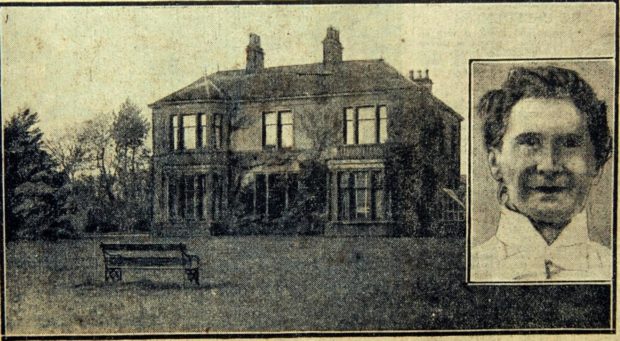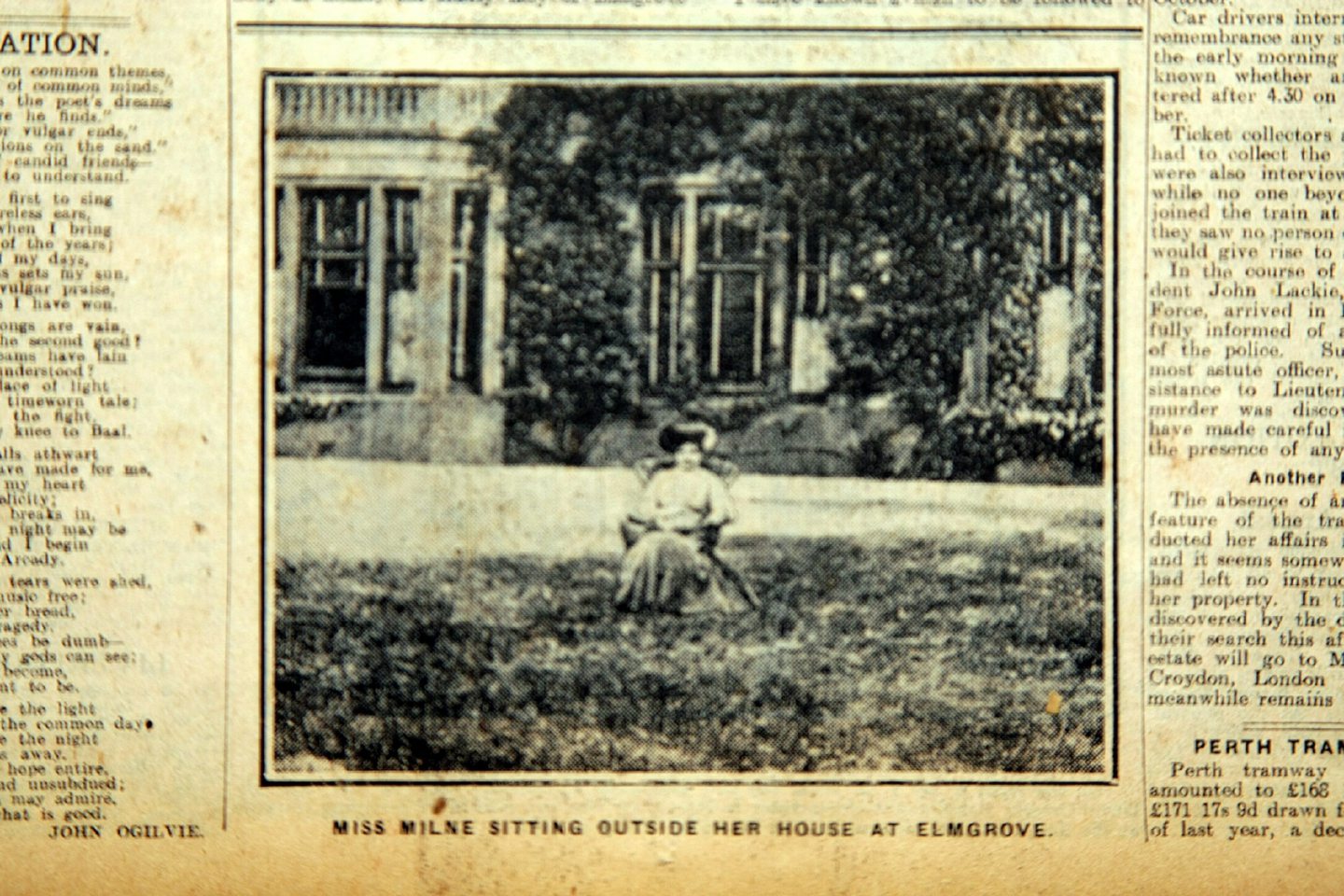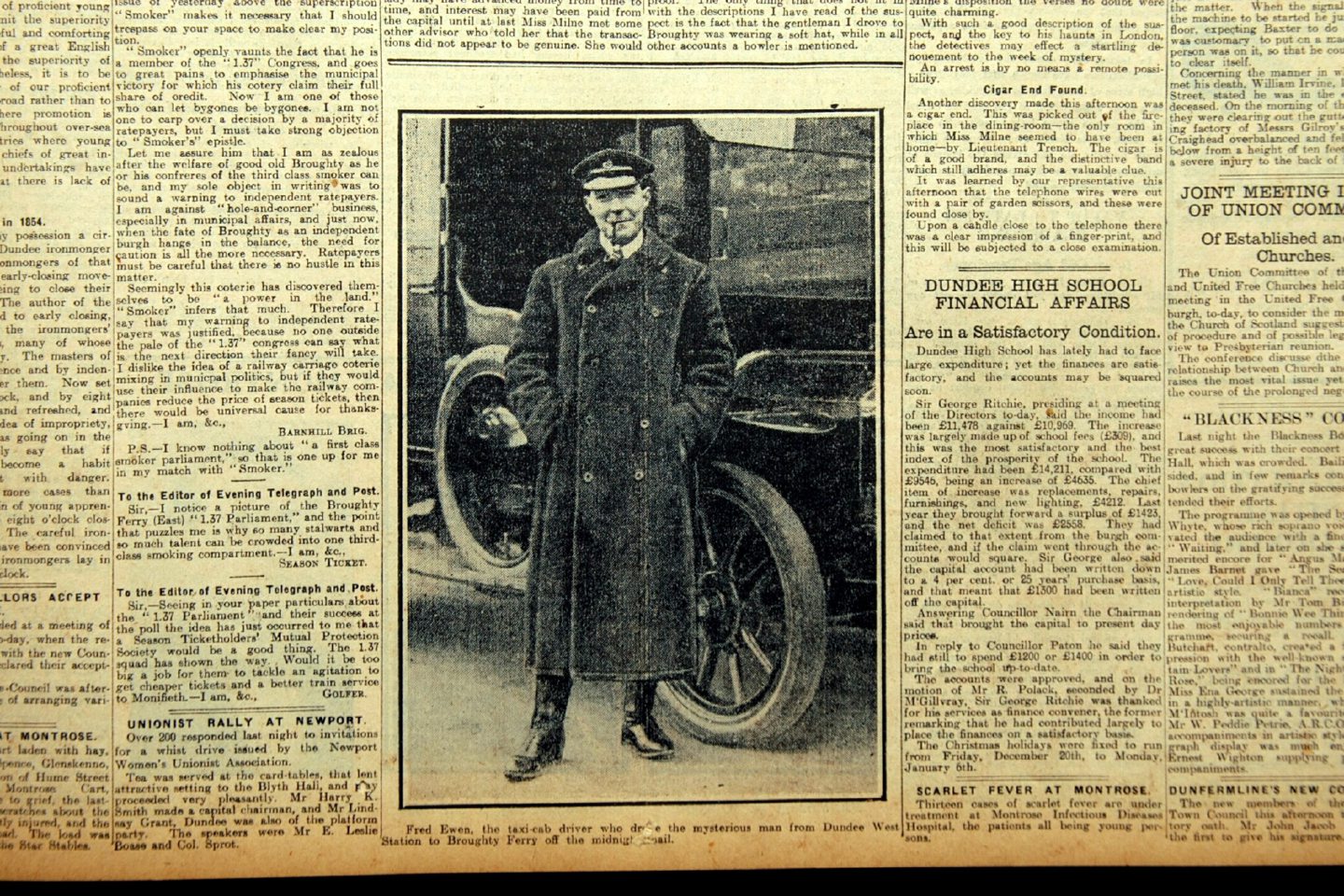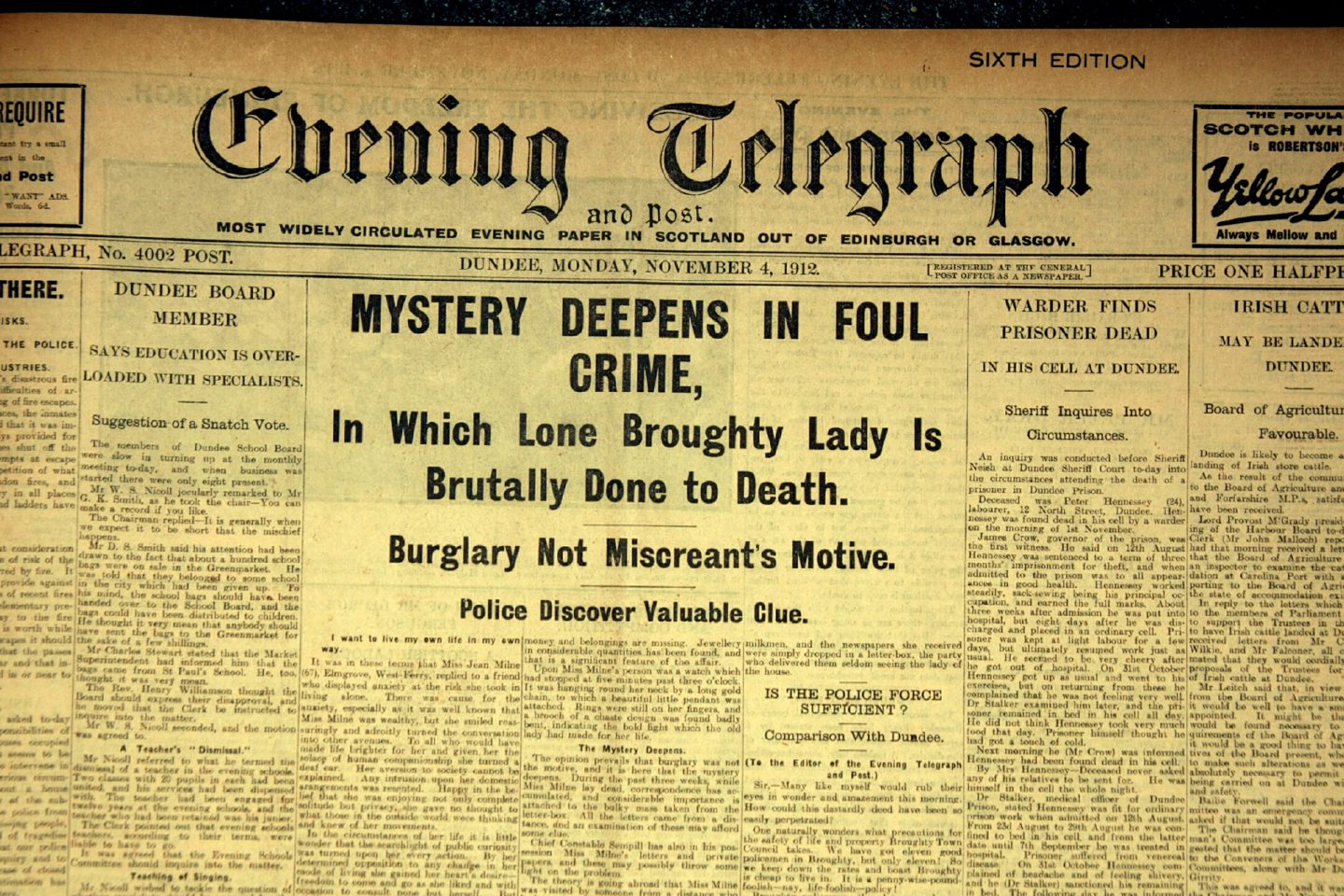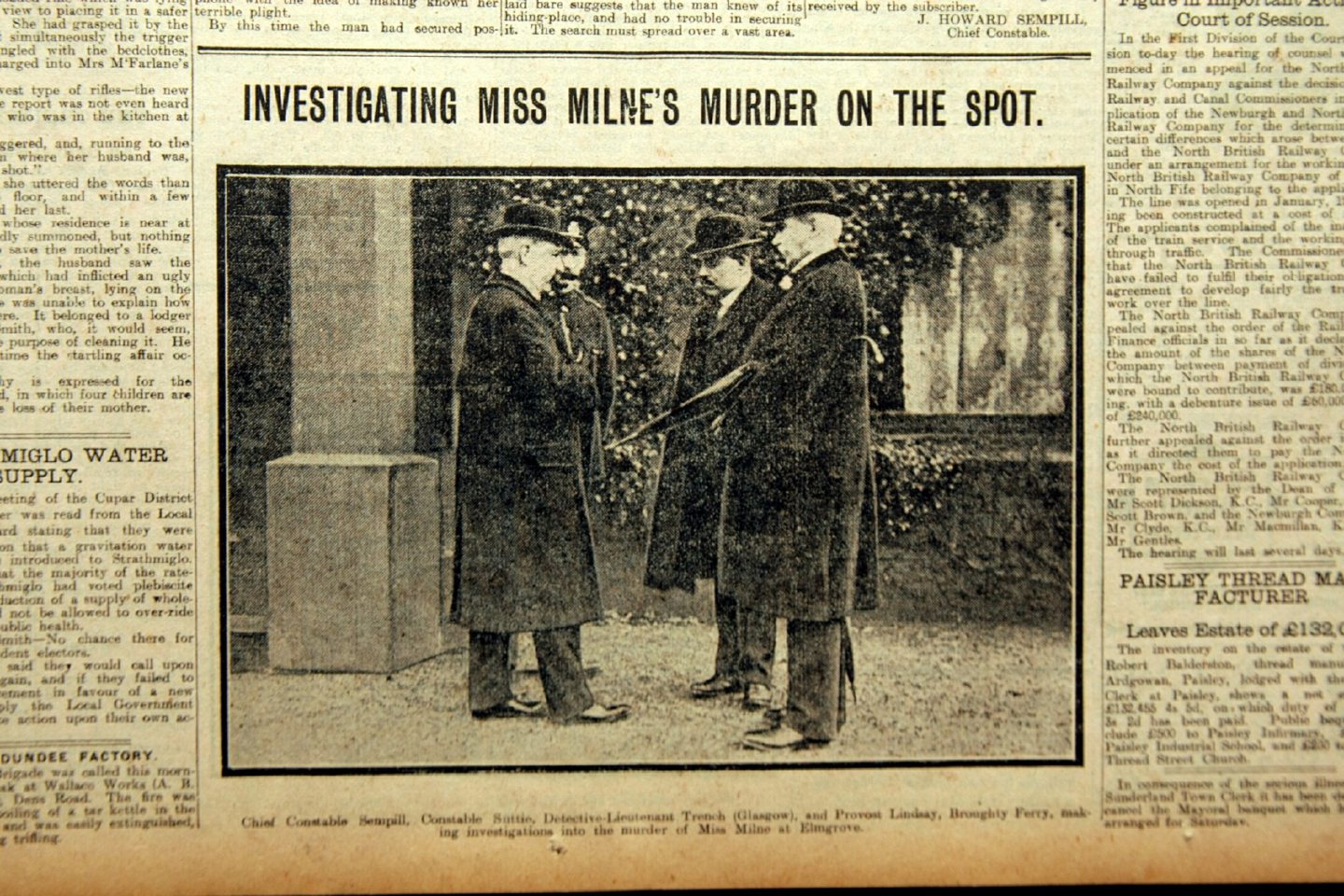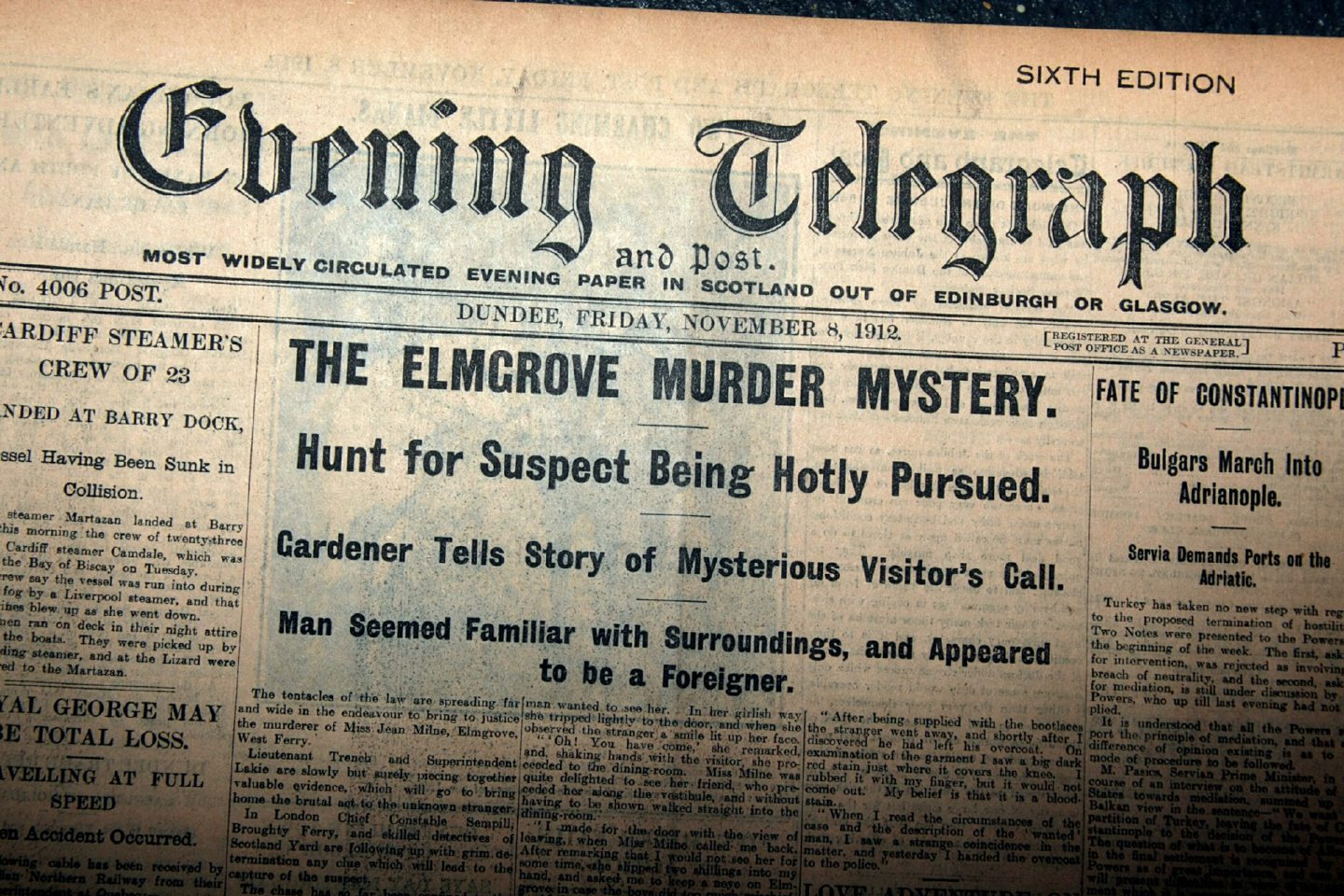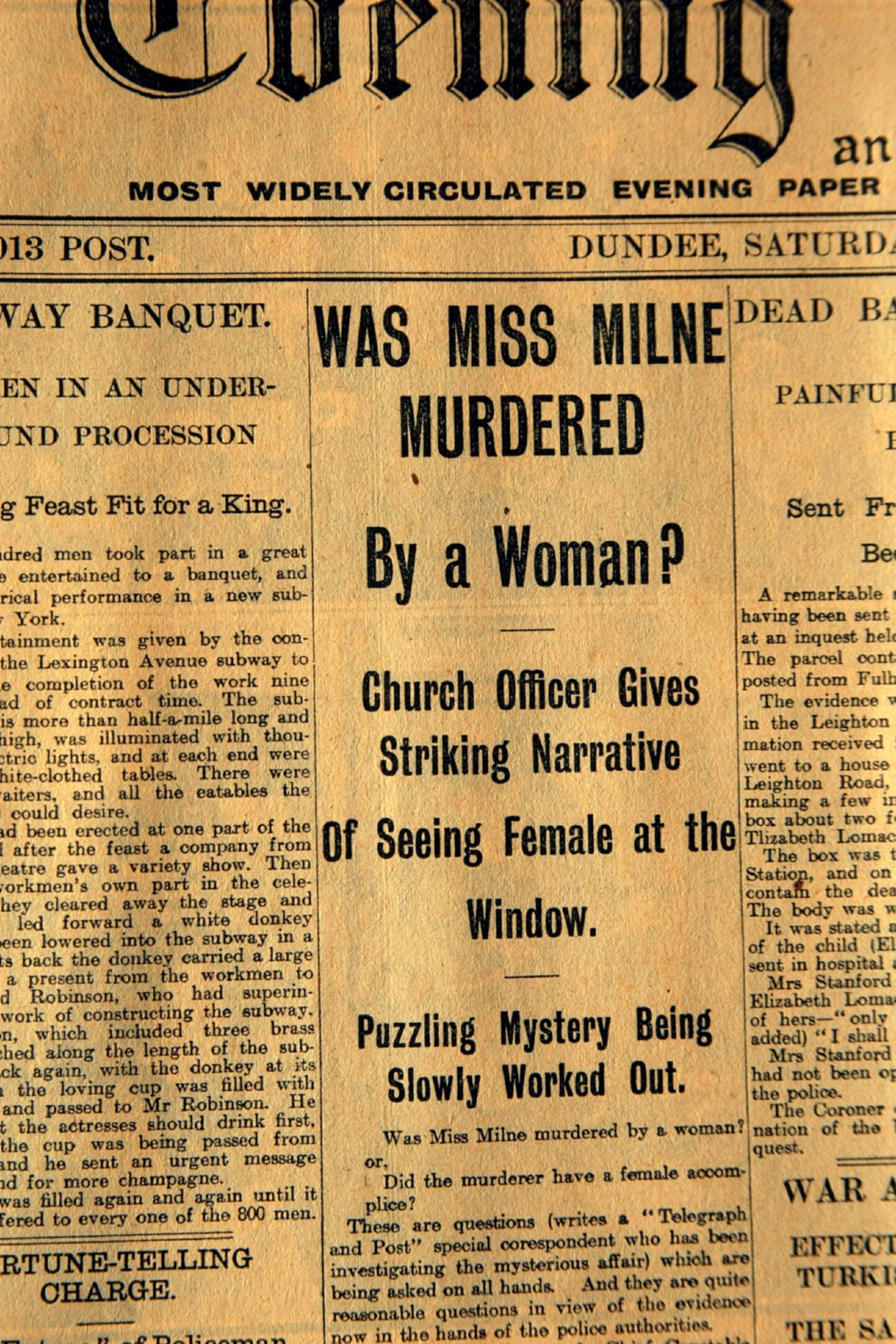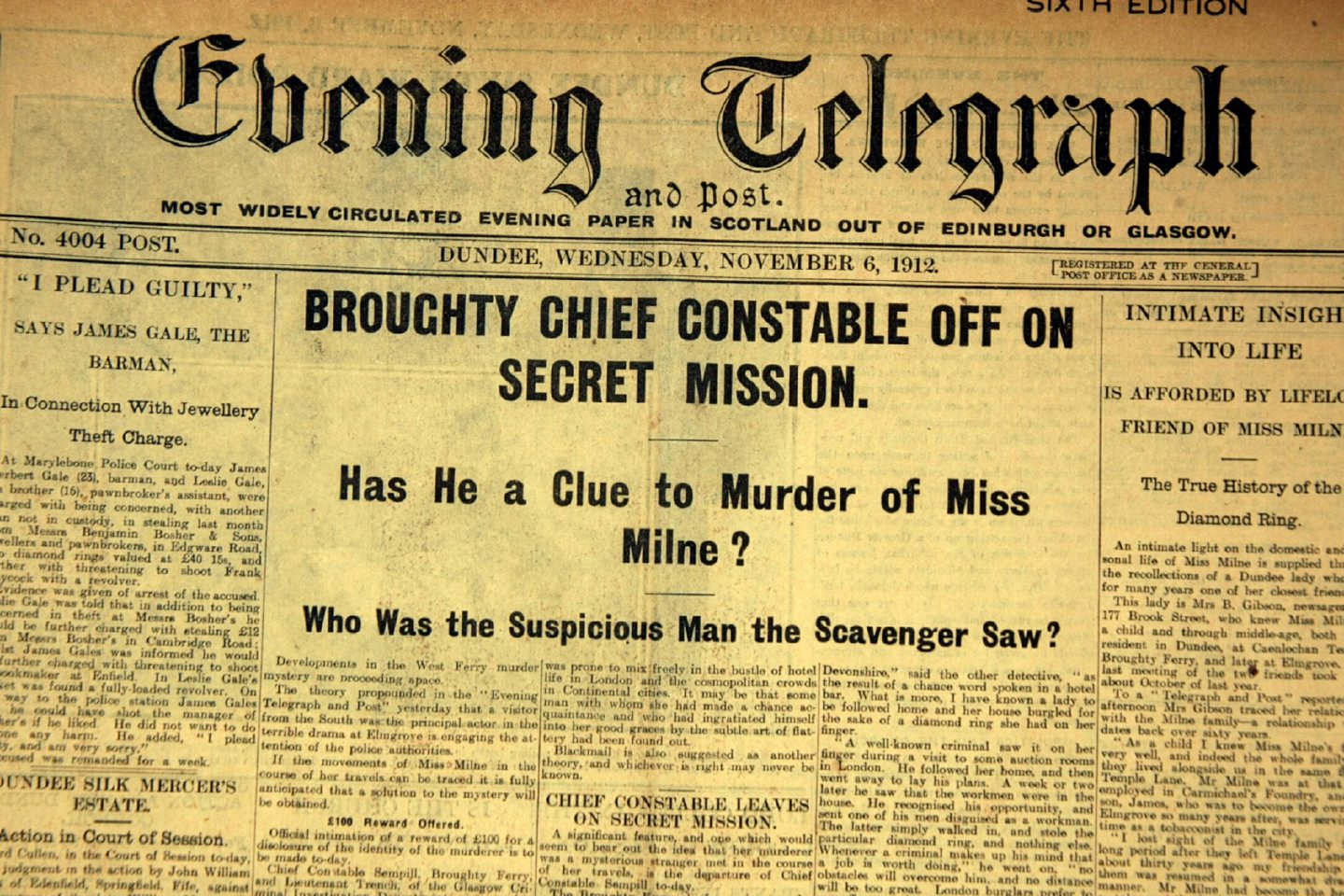Over 100 years ago the body of 69-year-old Jean Milne would be found bloodied at the bottom of the staircase of her grand Broughty Ferry home. Her legs were bound and money was stolen, but who murdered her? We may never know.
The killing of Jean in 1912 is now Dundee’s oldest unsolved murder case, and the second oldest in Scotland, but what did happen to the eccentric church goer and could the culprit have been a woman?
Who was Jean Milne?
Jean was born in Dundee and resided with her brother J H Milne, a wealthy tobacco
manufacturer, who bought the 23 room Elmgrove in 1895. Following her brother’s death in 1903 Jean was given the life rent of the property and lived off an annual
income of £1,000, worth over £110,000 in today’s money, from the rents of various properties once owned by him.
Despite living in the grand house, which was set in two acres of ground, it was later found that Jean only occupied two rooms in the home and despite her extreme wealth and a circle of friends, she led a rather quiet life with a strong involvement with the church and she rarely ever entertained in her home.
Jean’s neighbours would describe her as a church going eccentric living in “Bleak House” and would often hear her playing hymns on the organ in her home but despite her eccentricities they were fond of her and often concerned for her safety.
One neighbour told The Courier: “I could not tell you how many times I have advised Miss Milne not to shut herself up in that big house. It was unthinkable that a lady well up in years should prefer solitude.
“I remember some time ago Miss Milne telling me of an incident which showed how plucky she was. For many years, she had been sitting in her dining room writing or reading.
“The blinds of this room were never drawn, and she was there in full view of anyone in the garden. Well one night she became conscious of the fact that she was being watched.
“Lifting her head quickly she saw a man at the window, his face pressed hard against the glass. It was a trying experience, but Miss Milne was no way alarmed. Rising she walked to the window and coolly ordered the man to ‘clear out’.”
Despite being 69-years-old, Jean would dress younger than her age, never leaving the house without her magnificent jewellery, including up to seven diamond rings.
She would make a trip in to Dundee almost daily to dine in some of the best restaurants and would spend her afternoons attending public meetings or lectures, many of which were church related. Jean was said to be a “pillar” of the United Free Church in Dundee but was also known to be a generous supporter of other local churches too.
A woman of such wealth had to spend her money somehow and Jean did so by making frequent trips to London and abroad, holidaying for around four months a year, many of which she was joined by younger men.
A bloody discovery
At the end of October 1912 Jean had not been seen for some time, however this was not unusual considering her love of holidays and travel.
However, on November 2 postman, James Slidders, who delivered letters twice a day, could not get the mail into the box and thought this strange as she normally arranged for mail to be forwarded when she travelled.
Worried for Jean’s safety he called the local police.
The sergeant on duty was hesitant to call out a search though as previously when a worried Church Elder had contacted police, concerned that Jean was not answering calls, the sergeant had authorised a search of her property.
When Jean returned home safe and sound from an extended holiday, she was furious to discover her home and her privacy had been invaded.
Determined not to make the same mistake twice, the sergeant waited until the next day to see if she turned up.
When the missing woman still hadn’t appeared, the sergeant reluctantly authorised a search of Elmgrove.
Coullie, the local joiner, was tasked with forcing entry into the mansion and there Jean was found at the bottom of her staircase.
Jean had clearly been dead for sometime, she was found fully dressed and apparently bludgeoned to death by a poker.
A sheet partly covered her body with her legs bound with a window cord.
Close by was a two tine carving fork which was bloodstained and had been used to poke and prod the victim. She was left with at least 20 holes in her clothes with some puncturing her flesh. Blood was splattered up the walls and her false teeth, shattered and broken, were scattered on the stairs.
Despite the expensive jewellery Jean wore being untouched there was no money in the purse found beside the body yet nothing else in the home seemed to have been disturbed.
There was no sign of forced doors and all of the windows appeared to have not been opened for years, this led locals and investigators to believe she knew and possibly invited her attacker into the house.
A post mortem examination was carried out which showed that death was a result of shock and haemorrhage though her skull had not been broken.
She was buried in the Western Cemetery, Dundee, on November 5 with 14 invited guests in attendance.
The investigation begins
Broughty Ferry Chief Constable Howard J Semphill wasn’t used to leading murder investigations in the leafy suburb so immediately called in help from decorated investigator Detective Lieutenant John Trench of Glasgow.
Four years earlier Trench had won acclaim by solving a similar crime in Glasgow when a wealthy spinster was murdered.
With all Miss Milne’s possessions intact, Trench immediately queried the motive and the possible date of her death.
A reward of £100 was offered to anyone who could provide information leading to a conviction which brought forward many people with information of varying degrees of helpfulness.
Enquiries found Jean had attended church on October 13 and a Home Mission meeting in Dundee the next day.
All mail dated prior to October 14 was opened as was the local Advertiser of October 12, but the Telegraph of the same date was folded as if it had just been delivered.
A church elder had called at the house on October 16 but had not gained access so the assumption was made that she died early during October 15 or 16.
The date of her death would become crucial to the investigation.
Strange visitors spotted
Throughout the investigation many locals came forward to tell police of visitors they had spotted over the time period.
Dustman, James Don, gave a good description of a person all in black he saw leaving the house in the early hours of October 16.
After spotting James, the man re-entered the property.
Pedlar Andrew Hay would often call at the house however he got no answer at Elmgrove on October 15.
He did however see a smartly dressed man leave the home just before.
Margaret Campbell, a maid in the adjoining mansion, also told police of a man in full
evening address walk up and down in the garden for some 10 minutes in mid-October.
She described the man as being was six foot tall and broad while Jean’s gardener, John Wood, spotted a “foreign sounding gentleman”, about 5ft 8 inches tall, calling at the house around the same time.
Due to the descriptions of the men being incredibly varied the sightings actually complicated the investigation with the detectives being confused further when a Broughty Ferry Parish Church elder, John Troup, insisted he saw Miss Milne at an upstairs window on October 21 as he called to collect a donation on two occasions but
was met with no response.
Further witnesses would claim to see Jean in Dundee the week after the suggested
date of death.
According to the post-mortem the poker blows to Jean’s head were very light and would have been unlikely enough to kill her.
Could a women have committed the crime?
After all there was a sighting of a woman within the home well after the supposed date of death.
The arrest of Charles Warner
As the investigation continued, Trench and Semphill travelled to London to gather information from the hotels and restaurants Jean visited on her regular trips.
The murder was attracting attention across the country and a description of the suspect was forwarded to all police forces.
Ten days after the body was discovered Maidstone Police announced they had imprisoned a man for obtaining board and lodging by fraud.
Canadian Charles Warner was arrested and his photograph was sent for witnesses to identify in Broughty Ferry.
Five of the witnesses who had identified a male around Elmgrove agreed the man was Warner, with the three women and two men, put on a train to London to formally identify him.
Four of the witnesses identified him as the man they had seen at the home.
Charles was released from prison on his fraud charge but was then further detained on suspicion of murdering Jean. He was brought to Dundee where he appeared in court.
The only evidence against him? His similarity to the person seen at Elmgrove.
Enquiries in London revealed no one who had seen him in the company of Jean and there was also the problem of Charles having a strong alibi. He insisted he had never even been to Scotland and on the day of the murder a receipt proved he was in Antwerp where he had pawned a waistcoat.
The case against him dissolved and he was released in January 1913. No one else has ever been arrested in connection with the murder.
The following decades
John Trench returned to Glasgow and the mysterious case of Jean Milne’s murder ran cold. Over the decades many more theories have been explored but now in 2021 we are no closer to knowing the identity of her killer than locals were in 1912.
Elmgrove was sold to jute merchant, Colonel Hill in 1913 with the home’s name being changed to Moyness.
It was passed from merchant to merchant until 1973 when it became architect Hugh Martin & Partners offices. It was then converted to a nursing home
in 1987.
The house remains much the same as it was when built in 1876, although an extension was attached in 1995.
Unsolved Murder: Sandy Drummond’s tragic death still remains one of Fife’s most notorious cold cases
